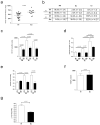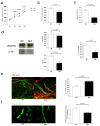Deletion of vascular endothelial growth factor in myeloid cells accelerates tumorigenesis
- PMID: 18997773
- PMCID: PMC3103772
- DOI: 10.1038/nature07445
Deletion of vascular endothelial growth factor in myeloid cells accelerates tumorigenesis
Abstract
Angiogenesis and the development of a vascular network are required for tumour progression, and they involve the release of angiogenic factors, including vascular endothelial growth factor (VEGF-A), from both malignant and stromal cell types. Infiltration by cells of the myeloid lineage is a hallmark of many tumours, and in many cases the macrophages in these infiltrates express VEGF-A. Here we show that the deletion of inflammatory-cell-derived VEGF-A attenuates the formation of a typical high-density vessel network, thus blocking the angiogenic switch in solid tumours in mice. Vasculature in tumours lacking myeloid-cell-derived VEGF-A was less tortuous, with increased pericyte coverage and decreased vessel length, indicating vascular normalization. In addition, loss of myeloid-derived VEGF-A decreases the phosphorylation of VEGF receptor 2 (VEGFR2) in tumours, even though overall VEGF-A levels in the tumours are unaffected. However, deletion of myeloid-cell VEGF-A resulted in an accelerated tumour progression in multiple subcutaneous isograft models and an autochthonous transgenic model of mammary tumorigenesis, with less overall tumour cell death and decreased tumour hypoxia. Furthermore, loss of myeloid-cell VEGF-A increased the susceptibility of tumours to chemotherapeutic cytotoxicity. This shows that myeloid-derived VEGF-A is essential for the tumorigenic alteration of vasculature and signalling to VEGFR2, and that these changes act to retard, not promote, tumour progression.
Figures




Similar articles
-
Targeting JAML promotes normalization of tumour blood vessels to antagonize tumour progression via FAK/SRC and VEGF/VEGFR2 signalling pathways.Life Sci. 2025 May 1;368:123474. doi: 10.1016/j.lfs.2025.123474. Epub 2025 Feb 19. Life Sci. 2025. PMID: 39983824
-
Decrease of VEGF-A in myeloid cells attenuates glioma progression and prolongs survival in an experimental glioma model.Neuro Oncol. 2016 Jul;18(7):939-49. doi: 10.1093/neuonc/now005. Epub 2016 Mar 6. Neuro Oncol. 2016. PMID: 26951383 Free PMC article.
-
A vascular niche and a VEGF-Nrp1 loop regulate the initiation and stemness of skin tumours.Nature. 2011 Oct 19;478(7369):399-403. doi: 10.1038/nature10525. Nature. 2011. PMID: 22012397
-
VEGFR3 Modulates Vascular Permeability by Controlling VEGF/VEGFR2 Signaling.Circ Res. 2017 Apr 28;120(9):1414-1425. doi: 10.1161/CIRCRESAHA.116.310477. Epub 2017 Mar 15. Circ Res. 2017. PMID: 28298294 Free PMC article.
-
Intracranial meningiomas, the VEGF-A pathway, and peritumoral brain oedema.Dan Med J. 2013 Apr;60(4):B4626. Dan Med J. 2013. PMID: 23651727 Review.
Cited by
-
Eosinophils orchestrate cancer rejection by normalizing tumor vessels and enhancing infiltration of CD8(+) T cells.Nat Immunol. 2015 Jun;16(6):609-17. doi: 10.1038/ni.3159. Epub 2015 Apr 27. Nat Immunol. 2015. PMID: 25915731
-
Vascular normalization as a therapeutic strategy for malignant and nonmalignant disease.Cold Spring Harb Perspect Med. 2012 Mar;2(3):a006486. doi: 10.1101/cshperspect.a006486. Cold Spring Harb Perspect Med. 2012. PMID: 22393532 Free PMC article. Review.
-
Hypoxia-Inducible Factor α Subunits Regulate Tie2-Expressing Macrophages That Influence Tumor Oxygen and Perfusion in Murine Breast Cancer.J Immunol. 2020 Oct 15;205(8):2301-2311. doi: 10.4049/jimmunol.2000185. Epub 2020 Sep 16. J Immunol. 2020. PMID: 32938724 Free PMC article.
-
Negative pressure wound therapy induces early wound healing by increased and accelerated expression of vascular endothelial growth factor receptors.Eur J Plast Surg. 2016;39:247-256. doi: 10.1007/s00238-016-1200-z. Epub 2016 Jun 13. Eur J Plast Surg. 2016. PMID: 27512293 Free PMC article.
-
Immune Regulation of the Metastatic Process: Implications for Therapy.Adv Cancer Res. 2016;132:139-63. doi: 10.1016/bs.acr.2016.05.004. Epub 2016 Jun 17. Adv Cancer Res. 2016. PMID: 27613132 Free PMC article. Review.
References
-
- Folkman J. Angiogenesis. Annu Rev Med. 2006;57:1–18. - PubMed
-
- Lewis JS, Landers RJ, Underwood JC, Harris AL, Lewis CE. Expression of vascular endothelial growth factor by macrophages is up-regulated in poorly vascularized areas of breast carcinomas. J Pathol. 2000;192(2):150–158. - PubMed
-
- Gerber H, et al. VEGF couples hypertrophic cartilage remodeling, ossification and angiogenesis during endochondral bone formation. Nature Medicine. 1999;5:623–628. - PubMed
-
- Clausen BE, Burkhardt C, Reith W, Renkawitz R, Forster I. Conditional gene targeting in macrophages and granulocytes using LysMcre mice. Transgenic Res. 1999;8(4):265–277. - PubMed
Publication types
MeSH terms
Substances
Grants and funding
LinkOut - more resources
Full Text Sources
Other Literature Sources
Molecular Biology Databases

